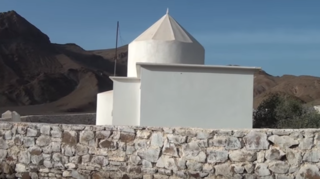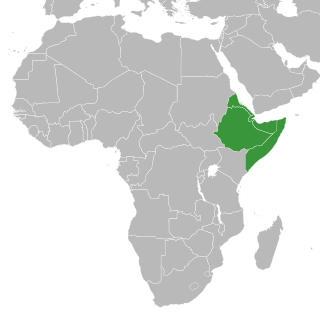
The Djibouti Armed Forces (DJAF) are the military forces of Djibouti. They consist of the Djiboutian Army and its sub-branches the Djibouti Air Force and Djiboutian Navy. As of 2018, the Djibouti Armed Forces consists of 20,470 ground troops, which are divided into several regiments and battalions garrisoned in various areas throughout the country. Djibouti Armed Forces are an important player in the Bab-el-Mandeb and Red Sea.

The culture of the Republic of Djibouti is diverse, due to the nation's Red Sea location at a crossroads of trade and commerce.
The Italian diaspora is the large-scale emigration of Italians from Italy. There are two major Italian diasporas in Italian history. The first diaspora began more or less around 1880, a decade or so after the Unification of Italy, and ended in the 1920s to early-1940s with the rise of Fascism in Italy. The second diaspora started after the end of World War II and roughly concluded in the 1970s. These together constituted the largest voluntary emigration period in documented history. Between 1880-1980, about 15,000,000 Italians left the country permanently. By 1980, it was estimated that about 25,000,000 Italians were residing outside Italy. A third wave is being reported in present times, due to the socio-economic problems caused by the financial crisis of the early twenty-first century, especially amongst the youth. According to the Public Register of Italian Residents Abroad (AIRE), figures of Italians abroad rose from 3,106,251 in 2006 to 4,636,647 in 2015, growing by 49.3% in just ten years.

The Issa are a northern Somali clan, a sub-division of the Dir clan family and is one of the largest clan of the Dir with a large and densely populated traditional territory.

Albanian Americans are Americans of full or partial Albanian ancestry and heritage in the United States. They trace their ancestry to the territories with a large Albanian population in the Balkans among others to Albania, Italy, Kosovo, North Macedonia and Montenegro. They are adherents of different religions and are predominantly Muslims, Christians as well as Irreligious.

Since the 17th Century BCE, conflicts have been occurring in the Horn of Africa. This is a list of conflicts in the Horn of Africa, which includes the nations of Djibouti, Eritrea, Ethiopia and Somalia.

The United States Census Bureau counted Minnesota's population at 5,303,925 in the 2010 Census.
Ethiopian Americans are Americans of Ethiopian descent, as well as individuals of American and Ethiopian ancestry.
African immigration to the United States refers to immigrants to the United States who are or were nationals of modern African countries. The term African in the scope of this article refers to geographical or national origins rather than racial affiliation. Between the Immigration and Nationality Act of 1965 and 2007, an estimated total of 0.8 to 0.9 million Africans immigrated to the United States, accounting for roughly 3.3% of all total U.S. immigrants during this period.
The Somali diaspora refers to expatriate Somalis who reside in areas of the world that have traditionally not been inhabited by their ethnic group. The civil war in Somalia greatly increased the size of the Somali diaspora, as many Somalis moved from Greater Somalia primarily to the Arabian peninsula, Europe, North America, Southern Africa and Australia. There are also small Somali populations in other pockets of Europe and Asia.

Somali Americans are Americans of Somali ancestry. The first ethnic Somalis to arrive in the U.S. were sailors who came in the 1920s from British Somaliland. They were followed by students pursuing higher studies in the 1960s and 1970s, by the late 1970s through the late 1980s and early 1990s more Somalis arrived. However, it was not until the mid and late 1990s when the civil war in Somalia broke out that the majority of Somalis arrived in the United States. The Somali community in the U.S is now among the largest in the Somali diaspora.

The Djiboutians are the people inhabiting or originating from Djibouti. The country is mainly composed of two ethnic groups, namely the Somali and the Afar. It has many languages though Somali and Afar are the most widely spoken ones, Arabic and French serve as the official languages. There is a small diaspora in North America, Europe, Australia.
Ethiopian Australians is a term that may be used to refer to immigrants from Ethiopia to Australia and their descendants. However, as Ethiopia is a multi-ethnic country with significant inter-ethnic tensions, not all immigrants from Ethiopia accept the label "Ethiopian", instead preferring to identify by their ethnic group. In particular, various Oromo groups use the term Oromo Australian instead.

The Norwegian diaspora consists of Norwegian emigrants and their descendants, especially those that became Norwegian Americans. Emigrants also became Norwegian Canadians, Norwegian Australians, Norwegian New Zealanders, Norwegian Brazilians, Kola Norwegians and Norwegian South Africans.
Djibouti is a transit and, to a lesser extent, a source and destination country for men, women, and children who are subjected to trafficking in persons, specifically conditions of forced labor and forced prostitution. There is little verifiable data on the human trafficking situation in Djibouti. Large numbers of voluntary economic migrants from Ethiopia and Somalia pass illegally through Djibouti en route to Yemen and other locations in the Middle East; among this group, a small number of women and girls may fall victim to involuntary domestic servitude or forced commercial sexual exploitation after reaching Djibouti City or the Ethiopia-Djibouti trucking corridor. An unknown number of migrants – men, women, and children – are subjected to conditions of forced labor and forced prostitution after reaching Yemen and other destinations in the Middle East. Djibouti's large refugee population – consisting of Somalis, Ethiopians, and Eritreans – as well as foreign street children remain vulnerable to various forms of exploitation within the country, including human trafficking. Older street children reportedly act, at times, as pimps for younger children. A small number of girls from impoverished Djiboutian families may engage in prostitution with the encouragement of family members or other persons in prostitution. Members of foreign militaries stationed in Djibouti contribute to the demand for women and girls in prostitution, including trafficking victims.

During the period of 2000–2005, an estimated 440,000 people per year emigrated from Africa; a total number of 17 million migrants within Africa was estimated for 2005. The figure of 0.44 million African emigrants per year pales in comparison to the annual population growth of about 2.6%, indicating that only about 2% of Africa's population growth is compensated for by emigration.
Middle Eastern Americans are Americans with ancestry, origins, or citizenship from the Middle East.
Somalis are an ethnic group in the Minneapolis–Saint Paul urban area and makes up the largest Somali diasporas in the US. As of 2016, there were around 74,000 Somalis in Minnesota.
Horn Africans in the United Kingdom are British citizens with ancestry from the Horn of Africa. They include Djiboutian, Eritrean, Ethiopian and Somali individuals.





















